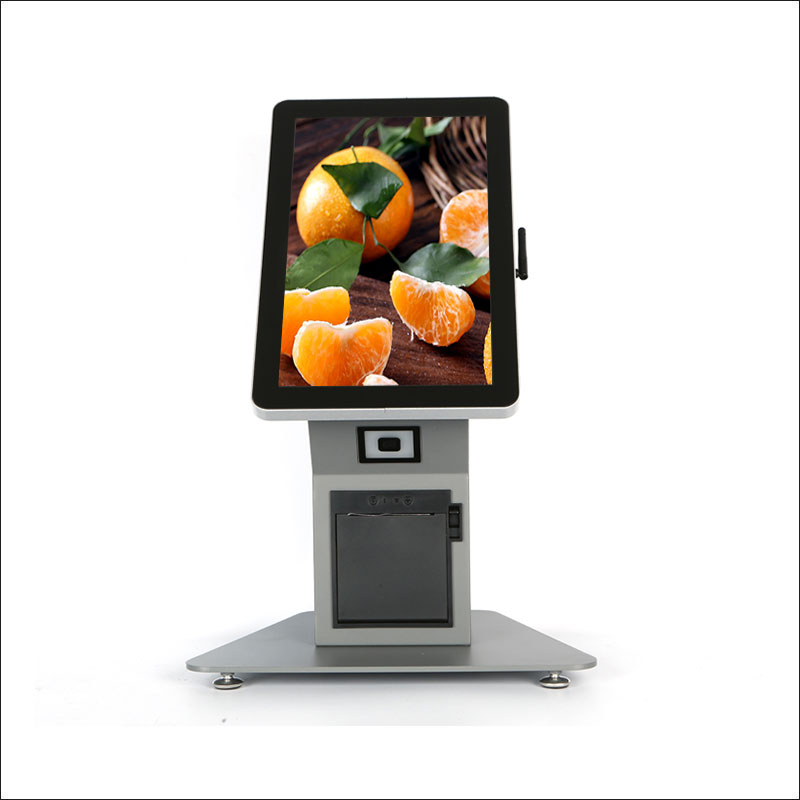- English
- Español
- Português
- русский
- Français
- 日本語
- Deutsch
- tiếng Việt
- Italiano
- Nederlands
- ภาษาไทย
- Polski
- 한국어
- Svenska
- magyar
- Malay
- বাংলা ভাষার
- Dansk
- Suomi
- हिन्दी
- Pilipino
- Türkçe
- Gaeilge
- العربية
- Indonesia
- Norsk
- تمل
- český
- ελληνικά
- український
- Javanese
- فارسی
- தமிழ்
- తెలుగు
- नेपाली
- Burmese
- български
- ລາວ
- Latine
- Қазақша
- Euskal
- Azərbaycan
- Slovenský jazyk
- Македонски
- Lietuvos
- Eesti Keel
- Română
- Slovenski
- मराठी
- Srpski језик
What is the advantage of Self Service Ordering Kiosk?
2023-07-28
Self-service ordering kiosks have become increasingly popular in various industries, especially in restaurants, fast-food chains, and retail stores. These kiosks offer several advantages for both businesses and customers. Here are some of the key advantages of self-service ordering kiosks:
 Faster Service: Self-service kiosks allow customers to place their orders directly without waiting for a cashier or server. This reduces order processing time and leads to faster service, especially during peak hours when there may be long lines at the traditional order counters.
Faster Service: Self-service kiosks allow customers to place their orders directly without waiting for a cashier or server. This reduces order processing time and leads to faster service, especially during peak hours when there may be long lines at the traditional order counters.
Reduced Waiting Times: With faster service, customers experience shorter waiting times, leading to increased customer satisfaction and a more positive overall experience.
Customization: Self-service kiosks often provide options for customization, allowing customers to tailor their orders to their preferences. This can include selecting ingredients, toppings, portion sizes, and more, leading to higher customer engagement and satisfaction.
Reduced Errors: Since customers input their orders directly into the kiosk, there is less chance of miscommunication or order errors that can occur when placing orders with a cashier.
Improved Order Accuracy: Self-service kiosks can display the entire menu with all available options, reducing the likelihood of missing out on certain items. This leads to more accurate orders and reduces the need for order corrections.
Upselling and Cross-Selling Opportunities: Self-service kiosks can be programmed to suggest additional items or promotions, leading to increased sales through upselling and cross-selling strategies.
Language and Accessibility Options: Self-service kiosks can offer multilingual options and accessibility features, making it easier for customers with language barriers or special needs to place their orders.
Data Collection and Analytics: Self-service kiosks can gather valuable data on customer preferences, popular menu items, peak hours, and more. This data can be used to make informed business decisions, optimize menu offerings, and improve operational efficiency.
Reduced Labor Costs: By utilizing self-service kiosks, businesses may be able to streamline their workforce and reduce the need for as many order-taking personnel. This can result in cost savings for the business.
Self-Payment Options: Many self-service kiosks also offer integrated payment solutions, allowing customers to pay for their orders directly at the kiosk. This further expedites the ordering process and reduces wait times.
24/7 Service: In certain settings, such as hotels or airports, self-service kiosks can provide continuous service, enabling customers to place orders or access information outside of regular business hours.

Reduced Waiting Times: With faster service, customers experience shorter waiting times, leading to increased customer satisfaction and a more positive overall experience.
Customization: Self-service kiosks often provide options for customization, allowing customers to tailor their orders to their preferences. This can include selecting ingredients, toppings, portion sizes, and more, leading to higher customer engagement and satisfaction.
Reduced Errors: Since customers input their orders directly into the kiosk, there is less chance of miscommunication or order errors that can occur when placing orders with a cashier.
Improved Order Accuracy: Self-service kiosks can display the entire menu with all available options, reducing the likelihood of missing out on certain items. This leads to more accurate orders and reduces the need for order corrections.
Upselling and Cross-Selling Opportunities: Self-service kiosks can be programmed to suggest additional items or promotions, leading to increased sales through upselling and cross-selling strategies.
Language and Accessibility Options: Self-service kiosks can offer multilingual options and accessibility features, making it easier for customers with language barriers or special needs to place their orders.
Data Collection and Analytics: Self-service kiosks can gather valuable data on customer preferences, popular menu items, peak hours, and more. This data can be used to make informed business decisions, optimize menu offerings, and improve operational efficiency.
Reduced Labor Costs: By utilizing self-service kiosks, businesses may be able to streamline their workforce and reduce the need for as many order-taking personnel. This can result in cost savings for the business.
Self-Payment Options: Many self-service kiosks also offer integrated payment solutions, allowing customers to pay for their orders directly at the kiosk. This further expedites the ordering process and reduces wait times.
24/7 Service: In certain settings, such as hotels or airports, self-service kiosks can provide continuous service, enabling customers to place orders or access information outside of regular business hours.



